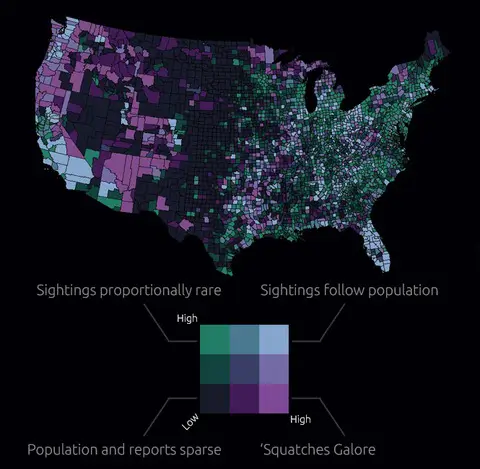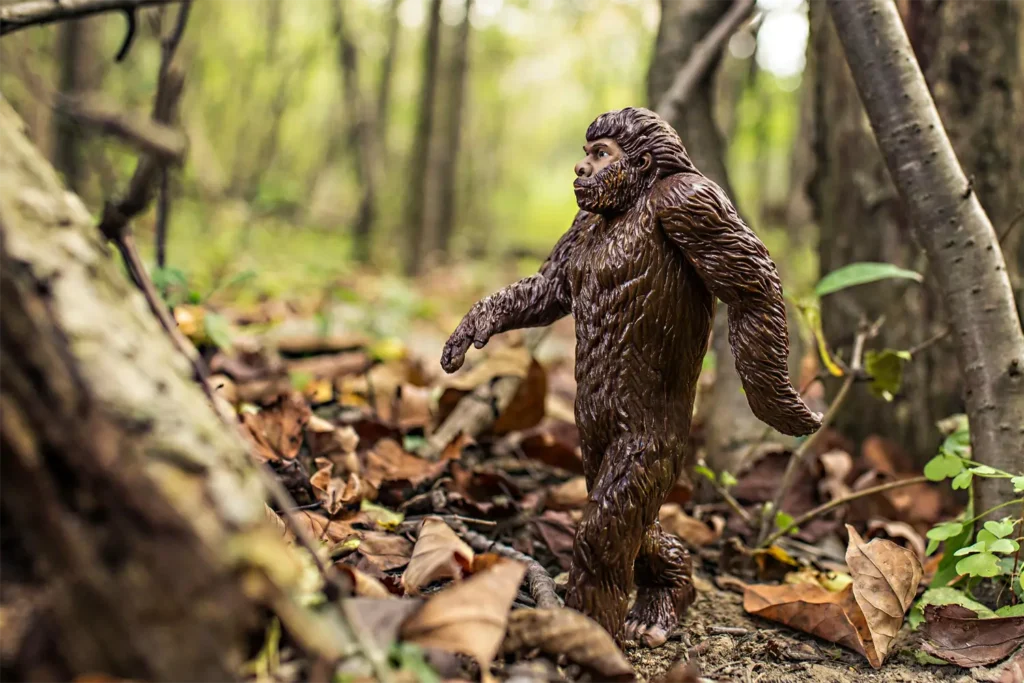I’ve been fascinated by the Bigfoot legend since I was a kid.
It’s an idea that’s been around for ages, dominating TV shows, cartoons, popular culture, and movies, and you’ll be hard-pressed to find someone who hasn’t heard of the big guy.
However, this is a relatively recent idea, with the first mentions dating back to around 1958. The term “Bigfoot” was seen in a small news piece published in the Humboldt Times, written by Andrew Genzoli, who spoke of a letter written by loggers in northern California who had discovered some mysteriously large footprints.
“Maybe we have a relative of the Abominable Snowman of the Himalayas,” he wrote.
While just a small column, the news surprisingly took off as readers became fascinated with the idea of a giant wild man roaming around the North American forests, woodlands, and mountain areas, and so, the myth was born.
But is this really a myth? Why did the loggers write the letter? Who or what made the footprints they spoke of? Why is there such a thing as a Bigfoot Field Researchers Organization (BFRO) that has recorded over 5,500 credible sightings?
Which is actually 3,000 if you quote PBS NewsHour or over 10,000, according to LiveScience.
There’s obviously a lot to unpack here, so let’s get stuck in.
As you probably know, Bigfoot is a large, hairy, ape-like man or creature who lives and roams around the forests of North America, specifically the Pacific Northwest.

Also known as the “Sasquatch,” maps of sightings have placed him all over the country and have created quite a cult following in the process.
Notably human-like, reports have placed Bigfoot as being quite similar to the Yeti, found in the mountains of Nepal and the Himalayas, some thinking the two are related.
As mentioned above, the first recordings are generally dated in the 1950s, but there have been plenty of other reports throughout history that lead us to believe Bigfoot has been around for almost a hundred years, if not centuries.
Of course, whether these are figments of the imagination, fleeting sightings, or something in between is the main topic of debate.
Most scientists don’t believe Bigfoot exists and have disproved most of the evidence that has been presented. In today’s world of portable cameras and smartphones, we seem to have lost the art of grainy photos with suspicious creatures lurking in the shadows, but what does that really tell us?
I’ll leave you to decide.
Onwards to the theories!

Now, let’s dive into the meat of the matter: what could Bigfoot actually be?
Is he just a large, hairy man, or is there something more to him? Where does he live? Who is his family? How does he also get all over the country to every forest, or are we seeing a secret population that just happens to be widespread?
Well, I have some ideas.
Starting with one of the most popular, there’s an idea that Bigfoot is actually a descendant of Gigantopithecus. This massive ape roamed Asia millions of years ago. Think bigger than a gorilla but smaller than King Kong.
Scientists have found Gigantopithecus fossils, mainly teeth and jawbones, in China, Vietnam, and India. These fossils suggest that Gigantopithecus was the largest ape that ever lived, standing up to 10 feet tall and weighing over 1,000 pounds.
Pretty crazy to think that actually lived.
Some researchers believe that Gigantopithecus may have migrated to North America across the Bering Land Bridge, which connected Asia and North America during the last ice age.
Of course, this means that over the centuries, the Gigantopithecus may have evolved to become smaller and less noticeable, especially with the rise of the oppressive human beings that may have hunted them down to protect themselves, so it would make sense they learned to stick to the shadows and out of field of view.
Could a population of these giant apes have survived in the remote wilderness, evolving into the creature we know as Bigfoot? It’s a tantalizing possibility.
Of course, it could be that Bigfoot is an entirely unknown species of primate altogether, one that has managed to evade detection by modern science.
When you consider that more than 80% of the world’s oceans are totally unexplored, and there are plenty of forest spaces, woodlands, and jungles that remain essentially uncharted (although there’s no exact figure for how much), the chances are there’s something out there we don’t know about.
Okay, this might seem far-fetched, but remember, new species are still being discovered all the time. Just think of the okapi, a giraffe-like creature discovered in the Congo rainforest in the early 20th century.
Proponents of this theory point out that many Bigfoot sightings describe a creature with features distinct from any known primate. Some reports mention a unique gait, unusual vocalizations, and even a distinctive odor.
Could these be clues that we’re dealing with a truly unique and undiscovered species?
No Bigfoot discussion would be complete without venturing into the realm of the paranormal.
Some believe that Bigfoot is an interdimensional being, a creature that can shift between our reality and others. Others suggest that Bigfoot sightings are somehow connected to UFOs and alien activity.
Personally, I think these ideas seem a little out there. If it were alien, they’d need to get here, which means they’d generally have better technology than ours, so why would they reside themselves living out of sight in the woods?
But who really knows? There are stranger things out there.
So, we’ve explored some wild theories, but what about the actual evidence? Well, that’s where things get even more interesting. Bigfoot enthusiasts point to various “proof,” though much of it is open to interpretation.
One of the most compelling pieces of “evidence” comes in the form of massive footprints.
These prints, often found in muddy or snowy terrain, are typically much larger than any human foot, sometimes measuring over 17 inches long and 7 inches wide.
Researchers have analyzed these footprints, creating plaster casts and studying their unique characteristics.
Some experts, like Dr. Jeff Meldrum, a professor of anatomy and anthropology at Idaho State University, believe that the footprints show anatomical features consistent with a large, bipedal primate.
Others, however, remain skeptical, suggesting the prints could be hoaxes or misidentified animal tracks.
Then there’s the hair. Over the years, numerous alleged Bigfoot hair samples have been collected. These samples have been subjected to microscopic analysis and DNA testing, but the results have been inconclusive.
Some samples have been identified as belonging to known animals like bears or humans, while others remain unidentified.
The problem is that getting a clean, uncontaminated Bigfoot hair sample is like trying to catch a greased piglet at a county fair. Which is tricky if you’ve never tried it. Even if we did get a perfect sample, there’s no guarantee that it would match anything in our existing DNA databases, which means it still wouldn’t prove anything.
And, of course, we can’t forget the eyewitness accounts.
Perhaps the most famous sighting comes from William Roe in 1955, who spotted a large “partly human, partly animal” creature while hiking on Mica Mountain in British Columbia.
As he wrote in his affidavit,
“As I watched this creature, I wondered if some movie company was making a film at this place and that what I saw was an actor, made up to look partly human and partly animal. But as I observed it more, I decided it would be impossible to fake such a specimen.”
On top of this, perhaps the most famous photo comes from California in 1967, which many people these days would call iconic.
This shot actually comes from a minute-long video known as the “Patterson-Gimlin” film, where a supposedly female Bigfoot is seen walking through the woods. Eerie, right?
Thousands of people claim to have seen Bigfoot, describing a tall, hairy creature that walks upright. These sightings come from all over North America, from the Pacific Northwest to the Appalachian Mountains.
Therefore, some witnesses are seasoned outdoorspeople, like hunters and hikers, who are familiar with the local wildlife. Others are everyday folks who stumbled upon something extraordinary. While eyewitness testimony can be compelling, it’s also notoriously unreliable.
Memory is a fickle thing, and it’s easy to misinterpret what we see, especially in fleeting glimpses or stressful situations.
Science says that if you walk past a dark alleyway and see a figure in the shadows, then your brain actually does see that thing.
It’s just that you look at it and are constantly updating the image in your head (remember, you don’t actually see anything, your eyes pick up light that converts into electrical signals in your brain, which you “see”) until you have enough information to see it’s just a stack of boxes or abandoned trolley cart.
But what if these people didn’t get any more information because they turned and ran? What if what they were seeing was the real thing?
After this deep dive into the world of Bigfoot, you might be expecting a definitive answer, a resounding “yes” or “no.” But as I’m sure you’ve gathered, the truth is far more elusive. The Bigfoot mystery remains just that – a mystery.
But even without concrete proof, the legend of Bigfoot continues to capture our imaginations. Why? Well, I think it taps into something deep within us, a fascination with the unknown, a yearning for something beyond the ordinary.
In a world that often feels predictable and mundane, Bigfoot represents a wild card, a reminder that there are still unexplored corners of our planet, secrets waiting to be uncovered.
And that’s quite a thrilling thought.
Whether you’re a die-hard believer or a staunch skeptic, I think there’s value in keeping an open mind. The world is full of surprises, and who knows, maybe one day, definitive proof of Bigfoot will emerge.
Until then, let’s enjoy the mystery, the speculation, and the thrill of the chase.
For those who are truly intrigued, the search for Bigfoot continues. Researchers, scientists, and amateur enthusiasts are still out there, scouring the forests, analyzing evidence, and hoping to glimpse the elusive creature.
Who knows, maybe you’ll be the one to finally solve the mystery. Just remember to pack your camera (and maybe a big can of bear spray, just in case!). 😉
References:
No filler. Just the good stuff, glazed with care.
No filler. Just the good stuff, glazed with care.